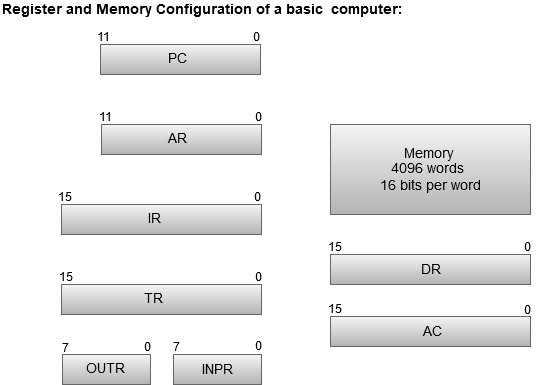Which Register Holds A Copy Of The Instruction Being Executed
next → ← prev
Computer Registers
Registers are a blazon of computer memory used to speedily have, store, and transfer information and instructions that are existence used immediately by the CPU. The registers used by the CPU are often termed every bit Processor registers.
A processor register may agree an didactics, a storage address, or any data (such every bit flake sequence or private characters).
The estimator needs processor registers for manipulating data and a register for holding a memory accost. The register holding the retention location is used to calculate the accost of the side by side instruction after the execution of the current didactics is completed.
Post-obit is the list of some of the most mutual registers used in a basic computer:
| Annals | Symbol | Number of bits | Office |
|---|---|---|---|
| Data register | DR | 16 | Holds memory operand |
| Address annals | AR | 12 | Holds accost for the memory |
| Accumulator | AC | 16 | Processor register |
| Didactics register | IR | 16 | Holds instruction code |
| Program counter | PC | 12 | Holds accost of the education |
| Temporary register | TR | xvi | Holds temporary data |
| Input register | INPR | 8 | Carries input character |
| Output register | OUTR | eight | Carries output graphic symbol |
The following paradigm shows the register and memory configuration for a basic computer.

- The Retentivity unit has a capacity of 4096 words, and each give-and-take contains 16 bits.
- The Data Register (DR) contains 16 bits which concur the operand read from the retentivity location.
- The Memory Address Register (MAR) contains 12 bits which hold the address for the memory location.
- The Program Counter (PC) also contains 12 bits which hold the address of the next educational activity to be read from retentivity subsequently the electric current instruction is executed.
- The Accumulator (AC) register is a general purpose processing annals.
- The education read from retentivity is placed in the Instruction register (IR).
- The Temporary Register (TR) is used for holding the temporary data during the processing.
- The Input Registers (IR) holds the input characters given by the user.
- The Output Registers (OR) holds the output after processing the input data.
Side by side Topic COA Tutorial
← prev side by side →
 For Videos Join Our Youtube Channel: Bring together Now
For Videos Join Our Youtube Channel: Bring together Now
Feedback
- Send your Feedback to [email protected]
Aid Others, Please Share



Which Register Holds A Copy Of The Instruction Being Executed,
Source: https://www.javatpoint.com/computer-registers
Posted by: jordanrusten.blogspot.com


0 Response to "Which Register Holds A Copy Of The Instruction Being Executed"
Post a Comment